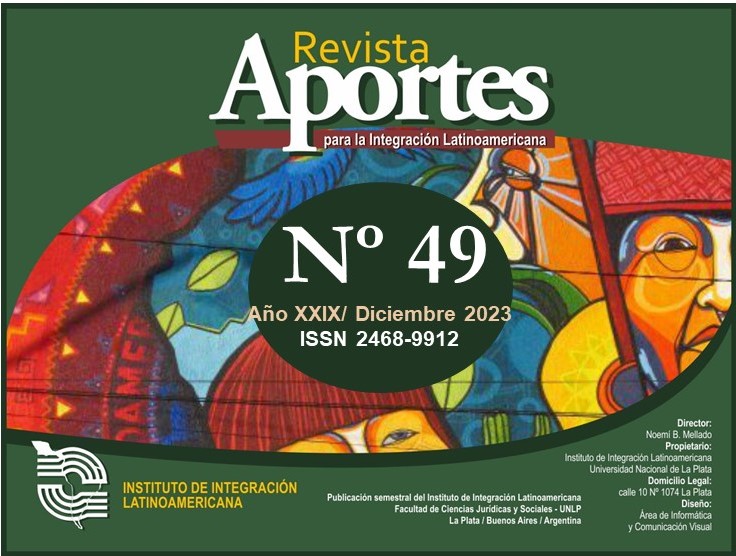Productivity Gap and Regional Integration in Latin America 1980-2019
DOI:
https://doi.org/10.24215/24689912e051Keywords:
economic integration, intraregional trade, efficiency, productivity, assymetriesAbstract
The ideal of Latin American integration had its political origins before its intellectual one. However, while today it has been consolidated as an intellectually desirable project; political progress has only been significant in the construction of overlapping sub-regional groups. Structural asymmetries have been considered as one of the reasons of it. Their impact on integration has been studied extensively; therefore, this paper looks at the opposite effect, i.e. integration on structural asymmetries. After calculating efficiency using DEA and decomposing multifactor productivity using Malmqüist, the results were compared to the evolution of an interdependence indicator for sixteen Latin American economies over the period of 1980-2019. Although the results are inconclusive, the evidence supports the hypothesis of a positive relationship between regional integration and efficiency.
Downloads
Metrics
References
Abramovitz, M. (1986). Catching up, forging ahead, and falling behind. The Journal of Economic History, 46(2), 385-406. https://doi.org/10.1017/S0022050700046209
Acemoglu, D. (2012). Introduction to economic growth. Journal of Economic Theory, 147(2), 545-550. https://doi.org/10.1016/j.jet.2012.01.023
Astorga, P., Berges, A. R. y Fitzgerald, V. (2011). Productivity growth in Latin America over the long run. Review of Income and Wealth, 57(2), 203-223. https://doi.org/10.1111/j.1475-4991.2011.00447.x
Balk, B. M. (2001). Scale efficiency and productivity change. Journal of Productivity Analysis, 15(3), 159-183. https://doi.org/10.1023/A:1011117324278
Barro, R. J. y Sala-i-Martin, X. (2003). Economic growth (vol.1). MIT Press Books.
Baumol, W. J. (1986). Productivity growth, convergence, and welfare: what the long-run data show. The American Economic Review, 76(5), 1072-1085.
Bouzas, R. (2003). Mecanismos para compensar los efectos de las asimetrías de la integración regional y la globalización: Lecciones para América Latina y el Caribe. El caso del MERCOSUR. BID.
Bouzas, R. (2017). El regionalismo en América Latina y el Caribe: ¿qué hay de nuevo? Estudios Internacionales, 49(SPE), 65-88. http://dx.doi.org/10.5354/0719-3769.2017.47533
Caselli, F. (2005). Accounting for cross-country income differences. En P. Aghion y S.N. Durlauf (Eds.), Handbook of economic growth (pp. 679-741). Elsevier North-Holland.
Caselli, F. (2016). The Latin American efficiency gap. En J. Thompson Araujo, E. Vostroknutova, K .M. Wacker y M. Clavijo (Eds.), Understanding the income and efficiency gap in Latin America and the Caribbean (pp. 33-56). World Bank. https://doi.org/10.1596/978-1-4648-0450-2_ch2
Coelli, T. (1996b). A guide to DEAP version 2.1: a data envelopment analysis (computer) program. Centre for Efficiency and Productivity Analysis, 96(08), 1-49. https://www.owlnet.rice.edu/~econ380/DEAP.PDF
Coelli, T., Rao, D. S. P., O'Donnell, C. J. y Battese, G. E. (2005). An introduction to efficiency and productivity analysis (2° Ed.). Springer Science.
Cole, H .L., Ohanian, L. E., Riascos, A. y Schmitz Jr, J. A. (2005). Latin America in the rearview mirror. Journal of Monetary Economics, 52(1), 69-107. https://doi.org/10.1016/j.jmoneco.2004.09.002
Cresta Arias, J. (2008). Asimetrías en el MERCOSUR: un enfoque macroeconómico. En F. Masi, M. I. Terra, R. Bouzas, J. Cresta Arias, y A. Lo Turco (Eds), Asimetrías en el MERCOSUR: impedimento para el crecimiento? Red Mercosur de Investigaciones Económicas.
Daude, C. y Fernández-Arias, E. (2010). On the role of productivity and factor accumulation in economic development in Latin America and the Caribbean. IDB Working Paper Series, (155), 1-46.
De Gregorio, J. (1992). Economic growth in Latin America. Journal of development economics, 39(1), 59-84. https://doi.org/10.1016/0304-3878(92)90057-G
Debreu, G. (1951). The coefficient of resource utilization. Econometrica: Journal of the Econometric Society, 19(3), 273-292. https://doi.org/10.2307/1906814
Easterly, W. y Levine, R. (2001). What have we learned from a decade of empirical research on growth? It's Not Factor Accumulation: Stylized Facts and Growth Models. The World Bank Economic Review, 15(2), 177-219. https://doi.org/10.1093/wber/15.2.177
Farrell, M. (1957). The measurement of productive efficiency. Journal of the Royal Statistical Society, 120(3) 253-281. https://doi.org/10.2307/2343100
Feenstra, R., Inklaar, R. y Timmer, M.P. (2015). The next generation of the Penn World table. American Economic Review, 105(10), 3150-3182. https://doi.org10.1257/aer.20130954
Fernández-Arias, E. y Rodríguez-Apolinar, S. (2016). The productivity gap in Latin America: lessons from 50 years of development. IDB Working Paper Series, (692). https://publications.iadb.org/en/productivity-gap-latin-america-lessons-50-years-development
Ferreira, P. C., Pessoa, S. D. A. y Veloso, F. A. (2013). On the evolution of total factor productivity in Latin America. Economic Inquiry, 51(1), 16-30. https://doi.org/10.1111/j.1465-7295.2011.00430.x
Gallardo-Albarrán, D. y Inklaar, R. (2021). The role of capital and productivity in accounting for income differences since 1913. Journal of Economic Surveys, 35(3), 952-974. https://doi.org/10.1111/joes.12374
Giordano, P., Mesquita Moreira, M. y Quevedo, F. (2004). El tratamiento de las asimetrías en los acuerdos de integración regional. INTAL – ITD, (26), 5-38. https://publications.iadb.org/es/publicacion/13475/el-tratamiento-de-las-asimetrias-en-los-acuerdos-de-integracion-regional
González, G. H., García-González, J. D., Gómez-Medina, J. S. y Corbella, V. I. (2023). Regionalization of Latin America based on asymmetries in the absorptive capacity of countries. The Journal of Economic Asymmetries, (27), e00291. https://doi.org/10.1016/j.jeca.2023.e00291
Gonzalez, G. H. y Delbianco, F. A. (2011). Apertura y productividad total de los factores: Análisis de la contemporaneidad en los quiebres estructurales para América Latina y el Caribe. Revista de análisis económico, 26(1), 53-81. http://dx.doi.org/10.4067/S0718-88702011000100003
Granato, L. y Perrotta, D. (2015). Asimetrías en la integración regional: de la ALALC al MERCOSUR. Perspectivas: Revista de Ciências Sociais, (45), 89-111.
Hall, R. y Jones, C. (1999). Why do some countries produce so much more output per worker than others? The Quarterly Journal of Economics, 114(1), 83-116.
Islam, N. (1995). Growth empirics: a panel data approach. The Quarterly Journal of Economics, 110(4), 1127-1170. https://doi.org/10.2307/2946651
Klenow, P. J. y Rodríguez-Clare, A. (1997). Economic growth: A review essay. Journal of monetary economics, 40(3), 597-617. https://doi.org/10.1016/S0304-3932(97)00050-0
Kojima, K. (1964). The pattern of international trade among advanced countries. Hitotsubashi Journal of Economics, 5(1), 16-36.
Koopmans, T.C. (1951). Analysis of production as an efficient combination of activities. En T.C, Koopmans (Eds.), Activity analysis of production and allocation (pp. 33-97). Wiley.
Kumbhakar, S. C. y Lovell, C. K. (2003). Stochastic frontier analysis. Cambridge University Press.
Lo Turco, A. (2008). Integración regional Sur-Sur y desarrollo industrial asimétrico: el caso del MERCOSUR. En F. Masi, M. I. Terra, R. Bouzas, J. Cresta Arias y A. Lo Turco (Eds.), Asimetrías en el MERCOSUR: impedimento para el crecimiento? Red Mercosur de Investigaciones Económicas.
Maddison, A. (1994). Explaining the economic performance of nations, 1820-1989. En W. J. Baumol, R. R. Nelson y E. N. Wolff (Eds.), Convergence of productivity: Cross-national studies and historical evidence (pp. 20-61). Oxford Academic.
Malmqüist, S. (1953). Index numbers and indifference surfaces. Trabajos de Estadística, 4(2), 209–242. https://doi.org/10.1007/BF03006863
Mankiw, N. G., Romer, D. y Weil, D. N. (1992). A contribution to the empirics of economic growth. The Quarterly Journal of Economics, 107(2), 407-437. https://doi.org/10.2307/2118477
Mesquita Moreira, M., y Córdova, E. L. (2015). Regional integration and productivity: the experiences of Brazil and Mexico. INTAL- ITD-ITD Working Paper, (14).
Peluffo, A. (2013). Regional integration and technology diffusion: The case of Uruguay. The Journal of International Trade & Economic Development, 22(5), 786-816. https://doi.org/10.1080/09638199.2011.605461
Petri, P. (2006). Is East Asia becoming more interdependent? Journal of Asian Economics, (17), 381-394. https://doi.org/10.1016/j.asieco.2006.04.001
Sanguinetti, P., Traistaru, I. y Volpe M., C., (2004). Economic integration and location of manufacturing activities: Evidence from MERCOSUR. ZEI Working Paper, (B11-04). http://hdl.handle.net/10419/39507
Torres Castillo, P. y Abad Godoy, J. (2019). Las asimetrías en la integración regional latinoamericana. En J. Briceño Ruiz, J. Leal, A. Rocha Valencia y M. Serna Forcheri (Eds.), La integración latinoamericana en debate: incertidumbre, formatos institucionales fragmentados y caminos alternativos latentes (pp. 283-306). Teseo
Viego, V. y Corbella, V. (2017). Specialization and exports in South America after trade agreements. Journal of Economic Integration, 32(2), 433-487. https://doi.org/10.11130/jei.2017.32.2.433
Downloads
Published
How to Cite
Issue
Section
License
Copyright (c) 2023 Germán González, Mario Seffino

This work is licensed under a Creative Commons Attribution-NonCommercial-NoDerivatives 3.0 Unported License.
Obras bajo licencia CC-BY-NC-ND
Esta licencia no permite la generación de obras derivadas ni hacer un uso comercial de la obra original, es decir, sólo son posibles los usos y finalidades que no tengan carácter comercial.


































